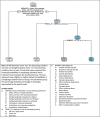Use of machine learning to examine disparities in completion of substance use disorder treatment
- PMID: 36149868
- PMCID: PMC9506659
- DOI: 10.1371/journal.pone.0275054
Use of machine learning to examine disparities in completion of substance use disorder treatment
Abstract
The objective of this work is to examine disparities in the completion of substance use disorder treatment in the U.S. Our data is from the Treatment Episode Dataset Discharge (TEDS-D) datasets from the U.S. Substance Abuse and Mental Health Services Administration (SAMHSA) for 2017-2019. We apply a two-stage virtual twins model (random forest + decision tree) where, in the first stage (random forest), we determine differences in treatment completion probability associated with race/ethnicity, income source, no co-occurrence of mental health disorders, gender (biological), no health insurance, veteran status, age, and primary substance (alcohol or opioid). In the second stage (decision tree), we identify subgroups associated with probability differences, where such subgroups are more or less likely to complete treatment. We find the subgroups most likely to complete substance use disorder treatment, when the subgroup represents more than 1% of the sample, are those with no mental health condition co-occurrence (4.8% more likely when discharged from an ambulatory outpatient treatment program, representing 62% of the sample; and 10% more likely for one of the more specifically defined subgroups representing 10% of the sample), an income source of job-related wages/salary (4.3% more likely when not having used in the 30 days primary to discharge and when primary substance is not alcohol only, representing 28% of the sample), and white non-Hispanics (2.7% more likely when discharged from residential long-term treatment, representing 9% of the sample). Important implications are that: 1) those without a co-occurring mental health condition are the most likely to complete treatment, 2) those with job related wages or income are more likely to complete treatment, and 3) racial/ethnicity disparities persist in favor of white non-Hispanic individuals seeking to complete treatment. Thus, additional resources may be needed to combat such disparities.
Conflict of interest statement
The authors have declared that no competing interests exist.
Figures
Similar articles
-
Residential and outpatient treatment completion for substance use disorders in the U.S.: Moderation analysis by demographics and drug of choice.Addict Behav. 2016 Jul;58:129-35. doi: 10.1016/j.addbeh.2016.02.030. Epub 2016 Feb 17. Addict Behav. 2016. PMID: 26925821
-
Racial and Ethnic Disparities in Outpatient Substance Use Disorder Treatment Episode Completion for Different Substances.J Subst Abuse Treat. 2016 Apr;63:25-33. doi: 10.1016/j.jsat.2015.12.007. Epub 2015 Dec 29. J Subst Abuse Treat. 2016. PMID: 26818489
-
Using machine learning to advance disparities research: Subgroup analyses of access to opioid treatment.Health Serv Res. 2022 Apr;57(2):411-421. doi: 10.1111/1475-6773.13896. Epub 2021 Oct 24. Health Serv Res. 2022. PMID: 34657287 Free PMC article.
-
How long does it take to complete outpatient substance use disorder treatment? Disparities among Blacks, Hispanics, and Whites in the US.Addict Behav. 2019 Jun;93:158-165. doi: 10.1016/j.addbeh.2019.01.041. Epub 2019 Jan 28. Addict Behav. 2019. PMID: 30711669
-
Gender and Cultural Adaptations for Diversity: A Systematic Review of Alcohol and Substance Abuse Interventions for Latino Males.Subst Use Misuse. 2018 Aug 24;53(10):1608-1623. doi: 10.1080/10826084.2017.1417999. Epub 2018 Jan 24. Subst Use Misuse. 2018. PMID: 29364763
Cited by
-
Assessing a pilot scheme of intensive support and assertive linkage in levels of engagement, retention, and recovery capital for people in recovery housing using quasi-experimental methods.J Subst Use Addict Treat. 2024 Mar;158:209283. doi: 10.1016/j.josat.2023.209283. Epub 2023 Dec 28. J Subst Use Addict Treat. 2024. PMID: 38159911 Free PMC article.
-
Factors predicting access to medications for opioid use disorder for housed and unhoused patients: A machine learning approach.PLoS One. 2024 Sep 27;19(9):e0308791. doi: 10.1371/journal.pone.0308791. eCollection 2024. PLoS One. 2024. PMID: 39331614 Free PMC article.
-
Toward Precision in Critical Care Research: Methods for Observational and Interventional Studies.Crit Care Med. 2024 Sep 1;52(9):1439-1450. doi: 10.1097/CCM.0000000000006371. Epub 2024 Aug 15. Crit Care Med. 2024. PMID: 39145702 Review.
-
Sex disparities in outcome of medication-assisted therapy of opioid use disorder: Nationally representative study.medRxiv [Preprint]. 2024 Sep 26:2024.09.24.24314320. doi: 10.1101/2024.09.24.24314320. medRxiv. 2024. Update in: Drug Alcohol Depend. 2025 Feb 01;267:112535. doi: 10.1016/j.drugalcdep.2024.112535. PMID: 39399057 Free PMC article. Updated. Preprint.
-
Determinants of outpatient substance use disorder treatment length-of-stay and completion: the case of a treatment program in the southeast U.S.Sci Rep. 2023 Aug 26;13(1):13961. doi: 10.1038/s41598-023-41350-8. Sci Rep. 2023. PMID: 37633996 Free PMC article.
References
-
- Richesson D, Hoenig JM. Key Substance Use and Mental Health Indicators in the United States: Results from the 2020 National Survey on Drug Use and Health. Substance Abuse and Mental Health Services Administration (SAMHSA), 2021. PEP21-07-01-003.
-
- McLellan AT, Luborsky L, O’Brien CP, Woody GE, Druley KA. Is treatment for substance abuse effective? JAMA. 1982;247(10):1423–8. - PubMed





